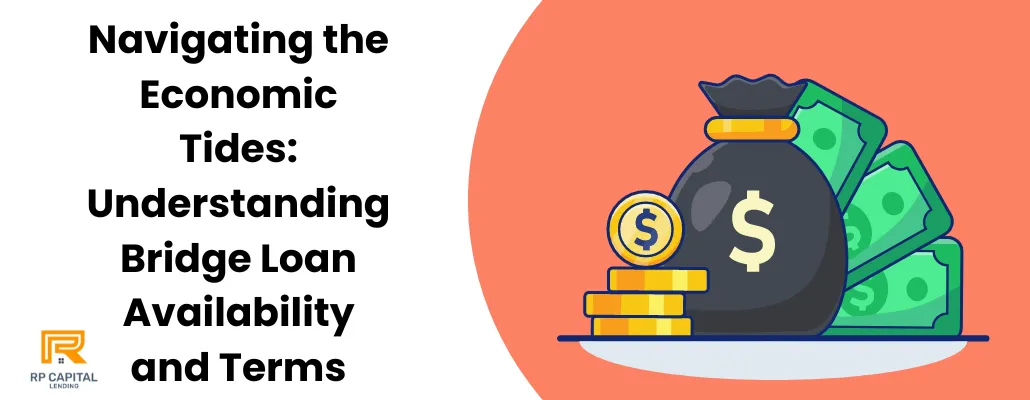
CALL ANYTIME
Blog

Navigating the Economic Tides: Understanding Bridge Loan Availability and Terms
In today's ever-fluctuating economic landscape, the quest for financial agility often leads businesses and individuals to consider bridge loans as a viable financing solution.
These short-term loans, designed to bridge the gap between immediate funding needs and longer-term financing solutions, are highly sensitive to the broader economic environment. This sensitivity raises a pivotal question: How do economic conditions impact bridge loan availability and terms?
Let's dive into the intricacies of this financial instrument and its relationship with the economic tides.
Introduction: The Quest for Financial Flexibility
Imagine standing on the brink of a significant investment opportunity. The only obstacle? Time-sensitive financing. This scenario, common in both personal and business realms, is where bridge loans shine as beacons of hope. Yet, their availability and the terms attached are not constants but fluctuate with the economic winds. Understanding this dynamism is crucial for anyone looking to navigate the financial waters successfully.
The Economic Influence on Bridge Loans
Bridge loans, by nature, are short-term and typically higher interest than long-term financing options. Their availability and terms can vary widely, influenced by several key economic factors:
1. Interest Rates
Direct Impact: The prevailing interest rates set by central banks are a primary determinant of bridge loan interest rates. Lower central bank rates can lead to more attractive bridge loan terms, while higher rates may result in increased costs.
Market Perception: Lenders’ perception of future interest rate movements can also shape bridge loan terms, with expectations of rising rates potentially tightening availability.
2. Market Liquidity
Availability of Funds: Higher market liquidity means more available funds, which can increase the availability of bridge loans and potentially improve terms for borrowers.
Lender Confidence: Conversely, in times of liquidity crunch, lenders may become more conservative, limiting the availability and tightening the terms of bridge loans.
3. Economic Health
Economic Growth: During periods of economic expansion, businesses and individuals are more likely to pursue new investments, increasing demand for bridge loans. Lenders, buoyed by a healthy economy, may offer more favorable terms.
Recessionary Periods: In contrast, during economic downturns, the risk of default increases, making lenders more cautious about issuing bridge loans, thus affecting their availability and terms.
4. Regulatory Environment
Government Policies: Regulations affecting lending and borrowing can directly impact bridge loan terms. For example, policies encouraging lending can make bridge loans more accessible, while stricter regulations may do the opposite.
Tax Considerations: Changes in tax policy regarding interest deductions or investment incentives can also influence the demand for and terms of bridge loans.
FAQs About Bridge Loans and Economic Conditions
Q1: How do I know if it's a good time to seek a bridge loan?
Assess the current interest rates, market liquidity, and overall economic health. A period of low interest rates and strong economic growth might be an ideal time to secure favorable bridge loan terms.
Q2: Can I negotiate the terms of a bridge loan?
Absolutely. While economic conditions set the stage, there's room for negotiation based on your creditworthiness, the collateral offered, and the lender's policies.
Q3: Are bridge loans more expensive during a recession?
Typically, yes. Lenders view the increased risk of default during recessions as a reason to raise interest rates and impose stricter terms.
Q4: How long does it take to get a bridge loan?
The timeframe can vary widely depending on the lender and the current economic conditions. Generally, it could take anywhere from a few days to several weeks.
Q5: Can economic conditions affect the length of a bridge loan?
Indirectly, yes. In a stable or booming economy, lenders might be more flexible with loan durations. However, in uncertain times, they may prefer shorter terms to reduce risk.
Conclusion: Sailing Through Economic Waves
The interplay between economic conditions and bridge loan availability and terms is a complex but navigable domain. By understanding the factors at play, borrowers can better position themselves to secure bridge loans that align with their financial needs and timelines, even amidst fluctuating economic currents. Whether you're a business on the brink of expansion or an individual facing a timely investment opportunity, knowledge of these dynamics can be your compass in the quest for financial flexibility.
In navigating these waters, always consider consulting with a financial advisor to tailor this knowledge to your unique situation, ensuring that your financial decisions are both informed and strategic. your post.
Disclaimer: Loans only apply to non-owner occupied properties. Rates, terms and conditions offered only to qualified borrowers, may vary upon loan product, deal structure, other applicable considerations, and are subject to change at any time without notice.
Copyright © 2025. All Rights Reserved.

